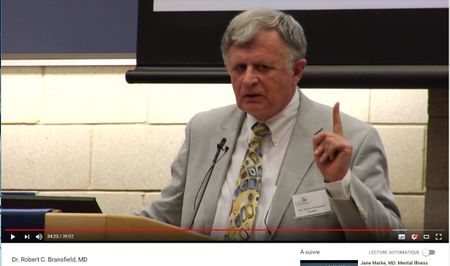Robert Bransfield
Révision datée du 12 mars 2018 à 15:04 par Victor (discussion | contributions)

Robert Bransfield le 3 mai 2014 à un séminaire de patients à Ridgefield (Connecticut)
Capture d'écran sur une vidéo youtube [1]
Capture d'écran sur une vidéo youtube [1]
Robert Bransfield ou Robert C Bransfield est un médecin psychiatre exerçant au Riverview Medical Center à Red Bank dans le New Jersey, ancien président de l'ILADS et de L'ILADEF (International Lyme and Associated Diseases Educational Foundation).
Références
- ↑ https://www.youtube.com/watch?v=7BbEBb-SzIE Vidéo mise en ligne le 16 juillet 2014 par Lyme Connection / Ridgefield Lyme Disease Taske (RLDTF)
- ↑ https://www.ncbi.nlm.nih.gov/pubmed/17980971 Article "The association between tick-borne infections, Lyme borreliosis and autism spectrum disorders", auteurs: Bransfield RC, Wulfman JS, Harvey WT, Usman AI, publié en 2008 dans Medical Hypotheses.
Abstract
Chronic infectious diseases, including tick-borne infections such as Borrelia burgdorferi may have direct effects, promote other infections and create a weakened, sensitized and immunologically vulnerable state during fetal development and infancy leading to increased vulnerability for developing autism spectrum disorders. A dysfunctional synergism with other predisposing and contributing factors may contribute to autism spectrum disorders by provoking innate and adaptive immune reactions to cause and perpetuate effects in susceptible individuals that result in inflammation, molecular mimicry, kynurenine pathway changes, increased quinolinic acid and decreased serotonin, oxidative stress, mitochondrial dysfunction and excitotoxicity that impair the development of the amygdala and other neural structures and neural networks resulting in a partial Klüver-Bucy Syndrome and other deficits resulting in autism spectrum disorders and/or exacerbating autism spectrum disorders from other causes throughout life. Support for this hypothesis includes multiple cases of mothers with Lyme disease and children with autism spectrum disorders; fetal neurological abnormalities associated with tick-borne diseases; similarities between tick-borne diseases and autism spectrum disorder regarding symptoms, pathophysiology, immune reactivity, temporal lobe pathology, and brain imaging data; positive reactivity in several studies with autistic spectrum disorder patients for Borrelia burgdorferi (22%, 26% and 20-30%) and 58% for mycoplasma; similar geographic distribution and improvement in autistic symptoms from antibiotic treatment. It is imperative to research these and all possible causes of autism spectrum disorders in order to prevent every preventable case and treat every treatable case until this disease has been eliminated from humanity. - ↑ https://www.ncbi.nlm.nih.gov/pubmed/?term=Kuhn+M%2C+Grave+S%2C+Bransfield+R%2C+Harris+S Article "Long term antibiotic therapy may be an effective treatment for children co-morbid with Lyme disease and autism spectrum disorder", auteurs: Kuhn M, Grave S, Bransfield R, Harris S, publié en mai 2012 dans Medical Hypotheses.
Abstract
Patients diagnosed with Lyme disease share many of the same physical manifestations as those diagnosed with an Autism Spectrum Disorder (ASD). In this study four male children (ages 26-55 months) who have an ASD diagnosis and one male child (age -O meets state and federal requirements for providing a comprehensive, ongoing assessment of a child with an ASD [33]. The SAP-O form measures children's abilities using observational, authentic assessment procedures in the domains of joint attention, symbol use, mutual regulation, and self regulation via observations of specific behaviors in familiar settings [33]. The five children tested positive for Lyme disease and their SAP-O score was evaluated before and after 6 months of antibiotic therapy. Each child was prescribed 200mg of amoxicillin three times per day and three of the five children were prescribed an additional 50mg of Azithromycin once per day. All of the children's scores on the SAP-O assessment improved after 6 months of antibiotic therapy. The assessors also reported anecdotal data of improved speech, eye contact, sleep behaviors, and a reduction of repetitive behaviors. - ↑ https://www.ncbi.nlm.nih.gov/pmc/articles/PMC4636014/ Article "Autism and Lyme Disease—Reply", auteurs: Mary Ajamian, MS, Anjali M. Rajadhyaksha, PhD, and Armin Alaedini, PhD, publié le 28 août 2013 dans JAMA.
In Reply
We evaluated the hypothesis that the rate of Lyme disease or associated seroprevalence is increased in children with autism as has been put forward by Dr Bransfield and others.1,2 A key assertion previously made in their Medical Hypotheses articles is that a substantial number of children with autism have active Lyme disease, with associated symptoms presumably resolving through antibiotic treatment.1,2 However, Bransfield and Kuhn now instead suggest that Lyme disease triggered autism in the affected children’s distant past (ie, B burgdorferi infection was no longer present), citing that as a reason why seropositivity could not be detected in any of the autistic children that we studied. Such a claim is contradictory to their previous argument for the association of autism with ongoing and antibiotic-responsive B burgdorferi infection. [...] - ↑ https://law.justia.com/cases/new-jersey/appellate-division-published/2008/a3035-07-opn.html JEFFREY SHECTMAN v. ROBERT BRANSFIELD, M.D
cet article est une ébauche